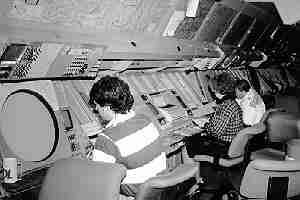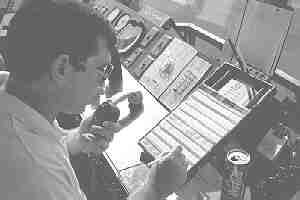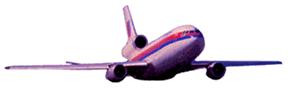 Remember when you were studying for your instrument written andyou came to the chapter on holding? Remember how your brain wentnumb and you had flashbacks to high-school algebra class? I realizethere are a few people who actually understood algebra (not me)and those same individuals probably understand how to enter aholding pattern while calculating their weight and balance andfuel remaining.
Remember when you were studying for your instrument written andyou came to the chapter on holding? Remember how your brain wentnumb and you had flashbacks to high-school algebra class? I realizethere are a few people who actually understood algebra (not me)and those same individuals probably understand how to enter aholding pattern while calculating their weight and balance andfuel remaining.
Luckily, as a controller, I’m never taxed to that extent. To theaverage Midwestern radar controller, the holding pattern is aboutas relevant as the light gun in the control tower. Not every controllercan tell you with certainty what an alternately flashing red andgreen signal means. That’s why every light gun has a sticker onthe back with all the signals decoded. In short, light guns, likeholding patterns, belong in the Smithsonian:
"Yes, son, that’s a holding pattern. We used those when therewas too much traffic on the NDB approach."
"Gee, Mom…what’s an NDB?"
The Old Days
 Or maybe I should rephrase that to ask: "What’s a hold?"The fact of the matter is, holds don’t top the list of cleverways to cope when there’s just too much traffic. Instead of figuringout an EFC time that the pilot won’t believe anyway, when radaris in use, it’s just a lot easier to slap on speed restrictionsand issue a few wide vectors. Pretty soon, everything smoothsout and settles back down to routine chaos.
Or maybe I should rephrase that to ask: "What’s a hold?"The fact of the matter is, holds don’t top the list of cleverways to cope when there’s just too much traffic. Instead of figuringout an EFC time that the pilot won’t believe anyway, when radaris in use, it’s just a lot easier to slap on speed restrictionsand issue a few wide vectors. Pretty soon, everything smoothsout and settles back down to routine chaos.
As you can probably surmise, it wasn’t always that way. In theold days, when pilots smoked cigars and controllers wore whiteshirts with skinny ties, holds were a standard way of doing business.Since radar didn’t exist, issuing vectors to airplanes you couldn’tsee wasn’t considered too sporting. All controllers could do wasrely on a pilot’s position reports and park him in a hold if hegot too close to other airplanes.
Back then, when controllers were first hired, they were sent tothe FAA Academy in Oklahoma City. After the usual haircuts andimmunizations, we were placed in a tiny classroom for many weeksworking simulated nonradar traffic. Each student would sit beforea board with lots of tiny flight progress strips representingaircraft with notations on route and altitude. The ATC instructorwould "start the clock" and airplanes would check onfrequency. The roles of the pilots were played by North KoreanPOWs masquerading as fellow student controllers.
Using the strips, the student would form a mental image of wherethe traffic was. For me, it was always a rather muddy image. Asmore and more simulated pilots checked on frequency, aircraftwould come into conflict-meaning they would hit. To avoid conflict,the student controller could whip a hold on a pilot, stoppingone aircraft’s progress along an airway until the conflictingaircraft had crossed safely, then the holding aircraft would becleared on course. This is basic non-radar ATC.
It ain’t easy. We hated it.
What’s even tougher is having an instructor sitting behind youevaluating your non-radar control technique, or lack thereof.As traffic complexity increased and controller perspiration respondedexponentially, more and more aircraft would come into conflict.Eventually, the simulated skies would be loaded with simulatedaircraft simulating midair collisions. That’s when the instructorwould throw down his clipboard and shout, "STOP THE CLOCK!"
With a flick of a switch on the timer, all the traffic would freezeand the instructor could point out the conflicts and offer thetrainee a resolution, such as finding alternate employment. Thepoint is, when air traffic becomes too congested, it has to bestopped. In the real world, we can’t stop the clock, so we haveto stop the traffic.
That’s easy when they’re on the ground. If the radar room findsitself buried in traffic, a controller can hit the panic buttonand tell the tower to stop departures. But if a radar controlleris inundated with arrivals and the localizer loads up, the preferredresponse is to just vector everyone around a little bit untilthe spacing sorts itself out.
Speed reductions can smooth out an arrival operation, too. Sloweverybody to 170 knots and you suddenly have a manageable group,except for the Cherokee who couldn’t do 170 knots pointed straightdown with the wings folded. (I don’t recommend that, by the way.)Believe it or not, holding really is a last resort, which is whyyou don’t do it very often.
Huh, No Radar?
 Quite a few ATC facilitiesstill work traffic non-radar. If you’re flying to one of thosedestinations and you need to shoot an approach-even a visual-andthere’s anyone else ahead of you, you can expect holding. If lotsof airplanes are inbound, a stack of airplanes is built over thesame fix.
Quite a few ATC facilitiesstill work traffic non-radar. If you’re flying to one of thosedestinations and you need to shoot an approach-even a visual-andthere’s anyone else ahead of you, you can expect holding. If lotsof airplanes are inbound, a stack of airplanes is built over thesame fix.
Once the first aircraft lands or cancels IFR, the next in thestack is cleared for the approach. If the stack on final getstoo crowded, then aircraft are held at outlying fixes and movedup as the final-approach holding pattern clears.
Building a stack is easy. The first aircraft in line is clearedfor the approach, then the second is held 1000 feet above thefirst, then the third aircraft is held 1000 feet above the secondand so on. This continues until approach runs out of airspaceor the pilots can’t breathe. At Des Moines, we can only stackto 10,000 feet without invading Center airspace. As an aircraftvacates an altitude, the whole stack is lowered a notch and thelatest arrival is tossed on top.
But what happens if you’re arriving in your past-TBO Cessna 172with your 250-pound mother-in-law and the stack tops out at 10,000feet? Are you expected to climb up and hold? Sometimes you are,but, as PIC, you can always decline that. It’s not unusual, innon-radar, to ask a pilot to climb 1000 feet for a hold or someother form of separation. Vertical separation is the easiest and,when I work, the safest form of separation.
Custom Patterns
When the Cessna arrives and can’t climb-maybe there’s ice above-then the controller will park it at an alternate fix. Each approachfacility has a rather crude non-radar map of the airspace. Holdingpatterns are depicted by large ovals surrounding various fixes-VORs,intersections, whatever. These holding patterns are not necessarilydepicted on pilot charts and are drawn according to TERPs ruleswhich say how much airspace is needed. The protected airspacefor a holding pattern increases with altitude, aircraft speedand distance from the navaid. Two holding patterns that are chartedto be separated at 5000 feet might overlap at 14,000, so onlyone can be used at a time at the higher altitude.
The maps are usually hand drawn using stencils for the variousholding patterns. The only problem is when the non-radar proceduresare actually used, controllers have no idea what the pilot isdoing in that holding pattern or even if the pilot has remainedinside the protected airspace.
It’s a system built on trust and a big sky. In a non-radar hold,the only "snitch" is the guy in the holding patternnext to you who’s getting tired of watching you overshooting thefix.
In non-radar operations with more than a one-in-one-out operation,the controller can resort to a really ancient procedure: timedapproaches. When one aircraft reports FAF inbound, the next aircraftin the pattern can be cleared for the approach with a restrictionto cross the FAF at or after a specified time. Tightly run timedapproaches can move a lot of airplanes if everyone hits the slot.The AIM (section 5-49) describes all of this, but don’t worrytoo much if you’ve never heard of it. Your chances of encounteringa timed approach are maybe a little less than hitting the Play20 lottery.
If you’re planning to operate in airspace controlled by a realnonradar approach control, then be ready to deliver when a controllerissues you a hold. Non-radar approach controls sometimes workwith smaller chunks of airspace than a radar facility might have.As a result, holding patterns are crammed in as close as possible.Staying inside your protected airspace is crucial.
Controllers are required to issue holding instructions at least5 minutes prior to the aircraft entering the hold. This givesthe pilot a chance to reread the AIM chapter on holding and getthe plane slowed to proper holding speed. Holding airspace isprotected around the fix based on the aircraft overshooting thefix upon entry. Enter too fast and you might slop into someoneelse’s protected airspace.
One of the surest ways to avoid a hold is to never get there.If ATC says, "Mooney One Two Three, cleared to the RalphVOR; hold south on the 180-degree radial; expect further clearanceat 1545; time now; 1530," then you may wish to reduce speedand eat up the delay en route rather than make circles. Of course,if ATC says, " . . .expect further clearance at. . . "then asks if you have a calendar handy, you may be in for a delayin the hold.
Technically, you are expected to begin speed reductions (if necessary)3 minutes prior to entering the hold . If you opt for the speedreduction prior to that to avoid the hold, you should inform ATC.Probably they won’t care. A Cessna at 80 knots isn’t much differentthan one at 110 knots. The main reason ATC needs to know who wantsto slow down to avoid a hold is so they can identify the weaksticks in the flow and make certain they’re last when things openup.
"Hey, Eudrice, watch this Cessna! He doesn’t know how tohold!"
Okay, so except for non-radar, you don’t encounter holds verymuch and even when you do, the controller may issue holding instructionseven though he or she knows you’ll probably never enter the assignedhold. Air traffic control involves a lot of rigid rules and lookingahead to see where everyone will be in a few minutes.
If two aircraft are inbound for the same airport, then, obviously,someone’s first and someone else follows. In the radar environment,a single minor heading change can establish the sequence.
When traffic volume increases, a combination of headings and speedcontrol establishes the order of events. When two aircraft mustshoot a non-radar approach, but the first aircraft will probablycancel IFR before the second one arrives, and the controller can’t100 percent guarantee that, then the second aircraft is issuedholding instructions, or "cleared short" of the destination.
If I’m working two aircraft in that situation, I’ll clear thefirst one for the approach and inform the pilot that someone’swaiting for him/her to cancel IFR. This is called "pimping"(see Pilot/Controller Glossary) and is used mostly at satelliteairports without control towers to encourage a pilot to cancelbefore actually landing. Of course, as PIC, if you’re feelingyou don’t want another aircraft right behind you as you circleto land, then you have every right to hold off on your cancellation.
In this case, the second aircraft in line is issued holding instructions,but the controller expects the first aircraft to be down beforethe subsequent aircraft has to enter the hold The holding takesplace only on paper and is called a "paper stop."
Real Holds
 When radar facilities do issue honest-to-goodness holds, it’susually because of weather, and often the hold comes at the pilot’srequest. Part 121 and 135 operators have varying op specs, butall share one requirement: The airport has to be reporting theminimum visibility required for the approach before they can acceptan approach clearance.
When radar facilities do issue honest-to-goodness holds, it’susually because of weather, and often the hold comes at the pilot’srequest. Part 121 and 135 operators have varying op specs, butall share one requirement: The airport has to be reporting theminimum visibility required for the approach before they can acceptan approach clearance.
In really low weather, RVR rises and falls almost by the minute,and if the field reports below minimums before the aircraft passesthe FAF, the crew will often request a hold until the RVR comesup. Often, we can spend a morning chasing the RVR up and down,switching from one runway to the other in hopes of getting a bettercombination of RVR reports and wind conditions. Despite everyone’sefforts, no one lands and, soon, the diehards in the hold arefiguring their fuel and continually asking ATC if the RVR hasimproved.
Of course, as a Part 91 driver, you can ignore that requirementand cruise right past that commuter doing spins over the markerat 5000 feet. (You still need landing minimums, however.) You,the PIC, make the decision whether to shoot the approach whenthe visibility deteriorates. A controller may have no idea whatyour requirements are or whether you’re operating under Part 91,121or 135. If I inform you that runway 31R RVR is 800 feet and yousay you want the approach, I’m going to clear you for it and towerwill clear you to land. It’s your call and the fact that threeairliners are in the hold awaiting another 400 feet of RVR hasno bearing on it.
Special Programs
Not all holding operations are because ATC has too many airplanesor because the weather stinks. Special operations, such as thearrival of presidential aircraft, can throw everyone else intoholding. Expect further clearance times are based on which politicalparty is onboard Air Force One. Republicans time their arrivalsand departures to the exact second, so we can issue EFCs withsome accuracy. A recent unnamed Democratic president, however,can’t seem to keep to a schedule, so EFCs tend to be vague. Imiss the Reagan years. When Nancy said A1 was departing at 1755Z,well, it departed.
When we actually do issue holds under radar control, we get towatch the pilots fumble through the entries. Entering a holdingpattern without looking like you’re trying to copy a Sean Tuckeraerobatic maneuver takes a little skill. But not much. What maybegin as a teardrop entry can degenerate into an endless cloverleaf that sorta, kinda goes around the holding fix.
When in doubt, some pilots panic and just dive on the fix thebest way they can in hopes of becoming reoriented. We call thisthe "tethered or bungee hold." Any attempt at timingeither inbound or outbound legs becomes sheer fantasy. The tetheredpilot just wanders around the fix trying to hold altitude andhoping ATC comes up with a clearance out of the hold.
Many pilots labor under the misconception that controllers knowall about hold entries and that they’ll spank you on the frequencyif you fly a parallel when you should have done a teardrop. Takeit from me: nobody cares. As long you’re flying vague ovals somewherenear the assigned fix and you stay out of everyone’s way, lifegoes on.
Twists and Turns
When holding in a radar environment, the controller is not requiredto apply merging-target procedures to turbojets at any altitudeor recips above 10,000 feet (see ATC 7110.65, 5-8). This meansyou may see the same MD-80 belly passing over you again and againwith no traffic call, while holding at Denver. If you don’t likeyour holding pattern you can ask for variations. If you want longerlegs or alternating left and right turns, you can request it.You can even request a block altitude in the hold if there aresome clouds around you that might be fun to chop up while you’rewaiting. There’s no regulation that says holding can’t be interesting.
Speaking of interesting, find a copy of Ralph Nader’s latest diatribeagainst living without a safety helmet. The book is entitled CollisionCourse (Tab Books.) I suppose all of us owe our very existenceto Ralph, and although his book is well written, (despite everysentence sounding like an air-raid warning), those who actuallyuse the system might occasionally wince. Ralph, of course, isconvinced the sky is falling.
Ralph devotes a few pages to the lost art of holding and seemsto mourn the declining use of the procedure. "First and foremostamong these (lost ATC skills) is the art of holding airplanes…."Ralph probably misses steam locomotives, button hooks and leisuresuits. He goes on to quote an unnamed ATC source: "Unfortunately,holding is fast becoming a lost art, except in the Eastern partof the United States."
Well, a tip of the headset goes out to all you folks holding overNew Jersey. But out here above the prairie, we’ve set that lostart out back of the barn with the old steam combine. Sure, wecould fire either one up should the need arise (spit), but I reckonwe can muddle along by keeping holding-pattern use to a minimum.And if any of you Easterners would like to check up on us, thenjust stop by the DSM tower, and we’ll brush the checkers off theradar scope and show you we can still issue a holding clearance.It’s easy. We just holler, "STOP THE CLOCK!"


































